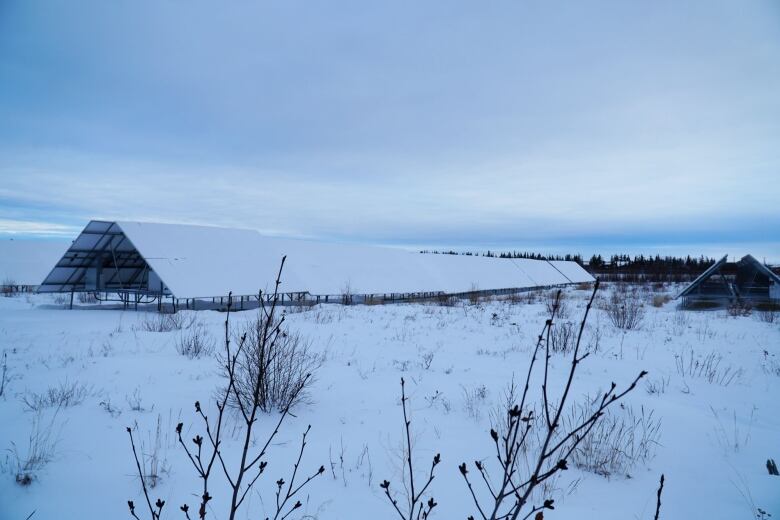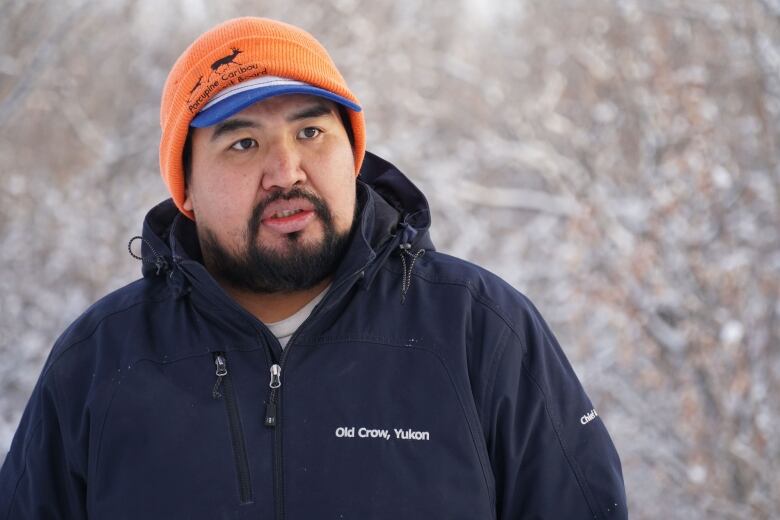In taking action on climate, this Arctic community wants to be a beacon to the world
Yukon town that is seeing effects of climate change
recently installed massive solar array
Our planet is changing. So is our journalism. This story is part of a CBC News initiative entitled Our Changing Planet to show and explain the effects of climate change and what is being done about it.
In Old Crow, the Yukon's northernmost community, some freezers still hum, even in late October.
That's odd. Typically, the appliances, which sit on porches, are plugged in during the summer but unplugged when it gets colder, as the frigid air does the work of refrigeration, averting the need to rely on expensive electricity.
The problem is, it isn't sufficiently cold yet.
When an Old Crow resident tells this story around a fire at a mountainside camp, the Vuntut Gwitchin elders standing nearby nod. They know all about the freezer situation.
There is snow everywhere here, 130 kilometres above the Arctic Circle, but by their standards, not much. It's cold, but not cold enough.
WATCH | How Old Crow is dealing with climate change:
A remote First Nation north of the Arctic Circle, Old Crow is seeing how climate change is impacting its landscape and wildlife populations. But the small community has big ambitions and vows to be carbon neutral by 2030. 7:58
The Porcupine caribou they rely on to hunt have returned, but the herd is late and there don't seem to be many of them in the area right now. It's not at all like those years when the mountains looked alive, there were so many caribou up there.
The caribou that have recently shown up dig through the snow for the nutritious lichen they crave and find some of it trapped under ice. This isn't good. The ice only forms because the weather has been warm enough for rain or wet snow, which eventually freezes. Snowfalls pile on top, but that ice has done damage by locking the lichen in.
Of course, the caribou can get through it with their snouts and hooves, but it takes energy they are trying to conserve. The hunters and elders in the area figure the caribou might move on to more fruitful feeding grounds.
This is the reality of the North in a changing climate. The Arctic is warming at a rate of two to three times the rest of the world, and while the signs of it may seem invisible to an outsider, they are disturbingly clear if you call Old Crow home.
'The ice is not safe to go on'
Seventy-five-year-old Elizabeth Kaye lives here and says it is deeply changed.
"I am excited to know that the caribou is here," she said. "But that excitement also changed for me because I waited so long and I should have already been done working with the caribou, all stored away and moving onto the next [task], which for me is ice fishing.
"But I can't go. The ice is not safe to go on. Way back, I used to go ice fishing in October. And here I am, still waiting."
What is especially worrying about changes in the North is a phenomenon called Arctic amplification. The more the Earth warms, the more it leads to conditions that cause additional warming.
Fabrice Calmels, research chair in permafrost and geoscience at Yukon University in Whitehorse and a collaborator on the Polar Knowledge Project, explains it this way:
"Sea and glacier ice, which used to reflect and send back solar heat energy, are melting. Therefore, more heat energy is absorbed by areas previously covered by ice, which results in additional warming. It is why if you [put] two cars under the sun, one being white, the other being black, you feel that the black one is much warmer."
Calmels studies permafrost thaw in Old Crow, which over the years has hosted climatologists, hydrologists and permafrost researchers. He says there are sensors throughout Old Crow evaluating the extent of the permafrost thaw. It is mapped, too, in order to measure and rank the risk in building on that land.
The scientists and the community work in concert to find ways to adapt and mitigate the effects of warming, but the data only backs up the experiences of people who have lived on the land.
Declaring an emergency
The elders appreciate the scientific work, but none of them standing around that crackling fire, waiting for the hunters to secure the caribou, need an international conference like COP26 in Glasgow, Scotland, to tell them the gravity of climate change.
The still-open water, thawing permafrost and eroding shorelines — which make some waterways inaccessible — offer evidence that screams at them.
This is why Old Crow has had it. More than fatigue, there is fear in waiting for the world's largest carbon emitters to care enough to act.
So in May 2019, the young chief, Dana Tizya-Tramm, declared a climate emergency, making this one of the first Indigenous communities to do so.
WATCH | Old Crow chief wants to inspire global climate action:
Turn captions Old Crow Chief Dana Tizya-Tramm talks to Adrienne Arsenault about his passion for fighting climate change and why he thinks if his Yukon village can promise to be carbon neutral by 2030, larger communities can too. 6:18
If you read the declaration, Tizya-Tramm says, "it's not asking anyone for anything. It's putting the world on notice at any table we sit at, internationally through the Arctic Council, nationally with the prime minister, regionally, climate change is going to be the No. 1 issue driving the conversation."
Once the declaration was issued, the First Nation got to work. For one thing, it pledged to be carbon neutral by 2030.
On the face of it, that seems a bit of a lofty, unreachable goal. Tiny Old Crow, 250-people strong, is a fly-in community that relies on diesel being flown in several times a year. The fuel the community needs to power the diesel generators every year produces emissions equivalent to 500 transatlantic flights.
Tizya-Tramm wants to find a way to turn off the generators for good. A solid start is the 2,000-panel solar project that sits alongside treasured berry patches. For a place with 24-hour sunshine in the summer, this has enormous promise.
Tizya-Tramm says it is the largest solar project in the North. When it turned on this summer, it enabled the community to turn off the diesel generators for the first time in nearly 50 years. Over the course of a year, that solar project will save 189,000 litres of diesel fuel.
Turning to the sun
The solar panels sit right outside the window of elder Lorraine Netro.
She used to have a clear view of the berry patch, which provided more than cranberries and blueberries — the act of picking is important culturally, physically and mentally. Looking at those huge solar panels, which now displace a little bit of the patch, took some getting used to, Netro admits.
"But we had to make that decision. As elders in this community.... How are we going to be part of this [climate] solution?"
Acting in the common good is a huge motivator for Vuntut Gwitchin and their chief, who wants their work to signal what is possible to everyone else.
"If my community with a single solar project can satisfy one quarter of our energy needs, if 250 people in a small village 80 miles north of the Arctic Circle can displace 189,000 litres of diesel fuel of their own volition, then we're showing community is where the strength is," he said.
The community is also about a year into a feasibility study on whether wind can help supply more power during the darkest winter months.
Then, there is the willow shrub, which seems especially fond of climate change. Thanks to warmer, wetter weather, it is growing taller and thicker than anyone ever remembers.
This poses a curious problem. The shrub chokes trails for animals and people, blocks access to berry patches and may be another contributor to shifting caribou migration patterns.
The shrub is a pain. But in it, Old Crow also sees opportunity.
Hunter and Deputy Chief Paul Josie, standing next to a shrub growing taller than him, says it happens to be an excellent biofuel. It grows so quickly that it can be harvested three or more times in seven-year cycles.
"It means putting it through a chipper and drying it to produce energy and heat," he said.
Aiming for a 'ripple effect'
This is where the wheels of leadership go into overdrive. There are willow shrub fuel projects elsewhere in the North and across the continent, so why not Old Crow?
What if, Chief Tizya-Tramm wonders, these projects can do more than cut down on the need for greenhouse gas-emitting diesel energy? What if they can bring jobs and income for the community?
"Instead of youth delivering newspapers like you might see in a neighbourhood in the city, our youth will be harvesting our willow species to burn in our incinerators," he hypothesized.
"Our solar panel project alone is generating about $410,000 dollars a year through a disruptive business model through our electricity purchase agreement with the local utility. Where we used to export that money, we're now bringing it back into the community."
Tizya-Tramm was invited to COP 26 but didn't go. The last time he went to a COP conference, he left early, feeling the voices of Indigenous people were marginalized. This time around, he sent a video instead.
"We can't give our power to any politician, to any CEO, to anyone," Tizya-Tramm said, capturing the essence of his message. "This is a time when we must embody and take our power as a household, as a family, as a community."
Tizya-Tramm and Josie both recently had baby daughters, and they keep their little ones and their futures in mind all the time. The challenge is how to keep the traditional ways alive, helped along with new, sustainable technology.
"I want to have all those cultural traditions ingrained in [my daughter's] life," Josie said with a smile. "We want to make these changes to start the ripple effect."






No comments:
Post a Comment